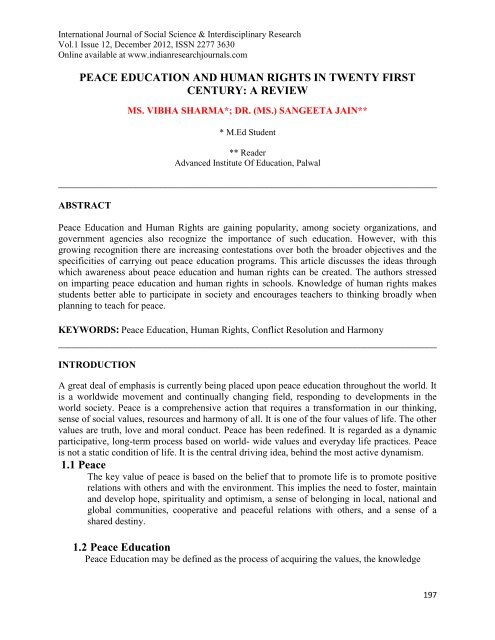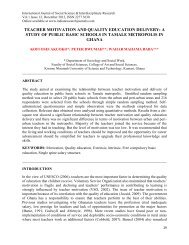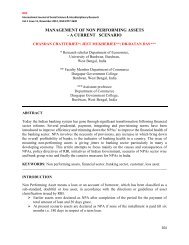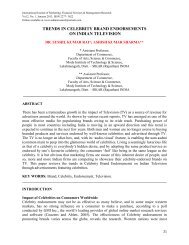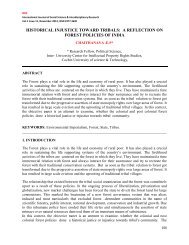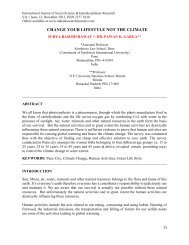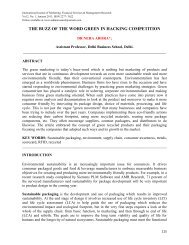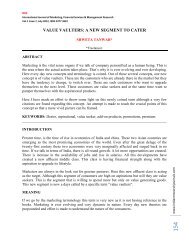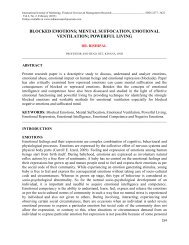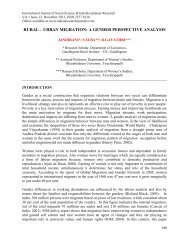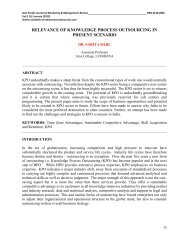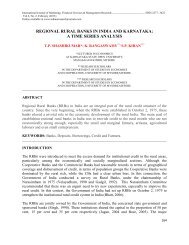PEACE EDUCATION AND HUMAN RIGHTS IN TWENTY FIRST ...
PEACE EDUCATION AND HUMAN RIGHTS IN TWENTY FIRST ...
PEACE EDUCATION AND HUMAN RIGHTS IN TWENTY FIRST ...
Create successful ePaper yourself
Turn your PDF publications into a flip-book with our unique Google optimized e-Paper software.
International Journal of Social Science & Interdisciplinary Research<br />
Vol.1 Issue 12, December 2012, ISSN 2277 3630<br />
Online available at www.indianresearchjournals.com<br />
<strong>PEACE</strong> <strong>EDUCATION</strong> <strong>AND</strong> <strong>HUMAN</strong> <strong>RIGHTS</strong> <strong>IN</strong> <strong>TWENTY</strong> <strong>FIRST</strong><br />
CENTURY: A REVIEW<br />
MS. VIBHA SHARMA*; DR. (MS.) SANGEETA JA<strong>IN</strong>**<br />
* M.Ed Student<br />
** Reader<br />
Advanced Institute Of Education, Palwal<br />
______________________________________________________________________________<br />
ABSTRACT<br />
Peace Education and Human Rights are gaining popularity, among society organizations, and<br />
government agencies also recognize the importance of such education. However, with this<br />
growing recognition there are increasing contestations over both the broader objectives and the<br />
specificities of carrying out peace education programs. This article discusses the ideas through<br />
which awareness about peace education and human rights can be created. The authors stressed<br />
on imparting peace education and human rights in schools. Knowledge of human rights makes<br />
students better able to participate in society and encourages teachers to thinking broadly when<br />
planning to teach for peace.<br />
KEYWORDS: Peace Education, Human Rights, Conflict Resolution and Harmony<br />
______________________________________________________________________________<br />
<strong>IN</strong>TRODUCTION<br />
A great deal of emphasis is currently being placed upon peace education throughout the world. It<br />
is a worldwide movement and continually changing field, responding to developments in the<br />
world society. Peace is a comprehensive action that requires a transformation in our thinking,<br />
sense of social values, resources and harmony of all. It is one of the four values of life. The other<br />
values are truth, love and moral conduct. Peace has been redefined. It is regarded as a dynamic<br />
participative, long-term process based on world- wide values and everyday life practices. Peace<br />
is not a static condition of life. It is the central driving idea, behind the most active dynamism.<br />
1.1 Peace<br />
The key value of peace is based on the belief that to promote life is to promote positive<br />
relations with others and with the environment. This implies the need to foster, maintain<br />
and develop hope, spirituality and optimism, a sense of belonging in local, national and<br />
global communities, cooperative and peaceful relations with others, and a sense of a<br />
shared destiny.<br />
1.2 Peace Education<br />
Peace Education may be defined as the process of acquiring the values, the knowledge<br />
197
International Journal of Social Science & Interdisciplinary Research<br />
Vol.1 Issue 12, December 2012, ISSN 2277 3630<br />
Online available at www.indianresearchjournals.com<br />
And developing the attitudes, skills, and behaviors to live in harmony with oneself, with<br />
others, and with the natural environment.<br />
According to James [1] peace education “encouraging a commitment to peace as a<br />
settled disposition and enhancing the confidence of the individual as an individual agent<br />
of peace; as encouraging the student to love the world and to imagine a peaceful future ;<br />
and as caring for the student to care for others.” According to Harris and Synott [2] by<br />
peace education teaching encounters that draw out from people their desires for peace<br />
and provide them with non-violent alternatives for managing conflicts , as well as the<br />
skills for critical analysis of the structural arrangements that legitimate and produce<br />
injustice and inequality.<br />
Betty Reardon [3] (2002) defines peace education as “the transmission of knowledge<br />
about the requirements of the obstacles to and possibilities for achieving and maintaining<br />
peace, training in skills for interpreting the knowledge, and the development of reflective<br />
and participatory capacities for applying the knowledge to overcoming problems and<br />
achieving possibilities.” Peace Education is seen as the way to transform individual‟s<br />
own mental models to use nonviolent critical and rational alternatives that produce peace<br />
consequences needed to solve conflicts without violence , and building mutually<br />
harmonious relationships.<br />
1.3 Need for Peace Education<br />
The need for peace education is by the fact that humanity faces challenges of<br />
unprecedented proportions, the continued development of weapons of mass destruction,<br />
conflicts between the states and ethnic groups, the spread of racism, community<br />
violence, the wide gap between the rich and poor throughout the globalised economy,<br />
massive violation of human rights and the degradation of the environment. In order to be<br />
equipped to tackle these complex and interwoven problems, the coming generation needs<br />
a radically different education in method and approach. The need for peace education is<br />
greater than ever before with a holistic approach to get credibility, status and<br />
accountability, peace education is more relevant in view of the recent terrorist attack on<br />
World Trade Centre on September 11, 2002, attack on Indian Parliament on December<br />
13, 2001 and the mounting tension for show down between India Pakistan, US and Iraq<br />
at present. All these undesirable developments and activities can be prevented at the<br />
grass root level by peace education.<br />
2. Related Work<br />
The United Nations declared the decade from 2001-2010 as the International Decade for<br />
a culture of Peace and Non – Violence in the world [4] (UNESCO,2000).That includes<br />
respecting all lives, ending of violence , and teaching nonviolence alternatives through<br />
education, dialogue , and cooperation.<br />
In The Hague appeal [5] for peace in May 1999 and beyond, Peace Education has been made<br />
a cross cutting theme in the first Hague (the Netherlands) International peace conference. It<br />
paves the way for making peace education a participatory process which changed the ways of<br />
thinking and promotes learning for peace and social justice.<br />
198
International Journal of Social Science & Interdisciplinary Research<br />
Vol.1 Issue 12, December 2012, ISSN 2277 3630<br />
Online available at www.indianresearchjournals.com<br />
The Hague Appeal for Peace and Global Campaign for Peace Education have two goals in<br />
views-<br />
<br />
<br />
To build public support and political awareness for the introduction of Peace<br />
Education into all fields of education including non – formal education in all<br />
educational institution all over the world and<br />
To education of all teachers to teach for peace<br />
The Hague appeal for peace education campaign brings together groups that focus on human<br />
rights, disarmament, and women‟s right and social justice to work together for abolishing war in<br />
the 21 st century.<br />
United Nations Educational Scientific and Cultural Organization (UNESCO) [6]<br />
recommendation of 1994 on education for international understanding, peace, human rights and<br />
fundamental freedom. Hence, UNESCO‟S 1994 action plan for education for peace, human<br />
rights and democracy proclaimed by the conference of Education Ministers and signed by 144<br />
countries of the world and the steady growth in the number of peace education courses offered<br />
by the schools, colleges and Universities throughout the world are other remarkable<br />
developments toward peace education.<br />
3. Human Rights<br />
The most appropriate route to impart peace education is primarily through education of<br />
Human rights. To promote peace education, understanding, acceptance and friendship<br />
Among all peoples and nations, there is a need to strengthen respect for human rights and<br />
Human freedoms.<br />
Human Right can be defined as the basic standards without which people cannot live in dignity<br />
as human beings. Human rights are the foundation of freedom, justice and peace. Their respect<br />
allows the individual and the community to fully develop. The development of human rights has<br />
it‟s in the struggle for freedom and equality everywhere in the world. The basis of human rights:<br />
such as respect for human life and human dignity, can be found in most religions and<br />
philosophies.<br />
They are proclaimed in the Universal Declaration of Human Rights. Documents such as the<br />
International Covenants of Human Rights set out what governments must do and also what they<br />
must do to respect the rights of their citizens.<br />
3.2 Characteristics of Human Rights<br />
<br />
<br />
Human rights do not have to be brought, earned or inherited, they belong to<br />
people simply because they are human- human rights are inherent to each<br />
individual.<br />
Human rights are the same for all human beings regardless of race, sex, and<br />
equal in dignity and rights – human rights are universal.<br />
199
International Journal of Social Science & Interdisciplinary Research<br />
Vol.1 Issue 12, December 2012, ISSN 2277 3630<br />
Online available at www.indianresearchjournals.com<br />
<br />
<br />
Human rights cannot be taken away; no one has the right to deprive another<br />
person of them for any reason. People still have human rights even when the<br />
laws of their countries do not recognize them , or when they violate them – for<br />
example , when slavery is practiced , slaves still have rights even though these<br />
rights are being violated – human rights are inalienable.<br />
To live in dignity, all human beings are entitled to freedom, security and<br />
decent standards of living concurrently. Human Rights Education is education<br />
for human rights. Human Rights Education is all about helping people to<br />
develop to the point where they understand human rights and where they<br />
feel that they are important and should be respected and defended.<br />
4. Imparting Peace Education in Schools:<br />
The world seems much smaller and almost instantly , global issues are becoming local , and the<br />
need for peace education becomes a necessity to build the maintain peace in students‟ families‟<br />
life, friendship groups, work place, neighbors, as well as within selves. Therefore, the need for<br />
peace education has arguably never been greater than it is today. Peace educating often includes<br />
an appreciation for diversity within a broad context of non-violence analysis and resolution.<br />
Teaching peace education in schools is a versatile and multi – disciplinary aspect. It includes<br />
teaching peace , non-violence, conflict resolution , and social justice , human rights concern for<br />
preserving the natural environment (Smith,2004) [7].<br />
Emphasizing peace education in schools is an essential need in our educational institutions. It<br />
starts first of all with an honest willing to engage educators in the learning process which is an<br />
essential and powerful way to transform their selves individually and collectively. The students<br />
need the skills to create and maintain peace. The methodology of Peace Education, therefore<br />
encourages<br />
<br />
<br />
Critical thinking and<br />
Preparing students to act on their convictions. Hence there is no magic wan approach<br />
to peace education. It will evolve and grow only through practice.<br />
The peace education can be imparted by considering the following methodologies;<br />
Creating a supportive classroom<br />
Investing conflict, violence and peace<br />
Visioning peaceful futures<br />
4.1 Creating a supportive Classroom Environment:<br />
Peace education makes special demands of teachers to make sure that their own<br />
classroom practices promote peace. According to the principles of peace pedagogy,<br />
pupils can learn how to bring peace to the world not only by studying issues of war and<br />
peace but also by learning certain skills, behaviours , and dispositions from classroom<br />
climate, which is established by the teacher structures his or her lessons.<br />
Practical approaches to creating a supportive classroom:<br />
Ian Harris [2] encourages that teachers should minimize or eliminate five unhelpful<br />
characteristics. In their place he advocates five peaces – seeking qualities. Teachers<br />
200
International Journal of Social Science & Interdisciplinary Research<br />
Vol.1 Issue 12, December 2012, ISSN 2277 3630<br />
Online available at www.indianresearchjournals.com<br />
could study the following table, thinking about where they would wish to locate their<br />
own practice along the continua:<br />
S.No. Unhelpful Characteristics Peace Making Qualities<br />
1. Teacher‟s claim to possession of the<br />
truth<br />
Respectful dialogue among teachers<br />
and learners<br />
2. Competitive classroom learners Cooperation among climate<br />
3. Student passivity Problem solving approaches to<br />
learning<br />
4. Student powerlessness Affirmation of the worth of each<br />
learner<br />
5. Teacher‟s use of authoritative force Democratic boundary setting of<br />
classroom expectations<br />
He also suggests that teacher is always also a learner. The teacher should celebrate<br />
diverse abilities and interests among students. He should also encourage cooperative<br />
attitudes and activities build knowledge, involve students in for setting culture in the<br />
classroom.<br />
4.2 Practising Peace:<br />
It could be helpful to think that „practising peace‟ begins with a search for „inner peace‟. The<br />
search for „inner peace‟ has captured the imagination of many people today; particularly it seems<br />
in western societies where alienation and disaffection seem to sit uneasily alongside<br />
unprecedented levels of material possession and consumption. Thus, students need to be<br />
respectful and open- minded without being uncritically tolerant and accepting. They need to be<br />
cooperative and empathetic while still being assertive. Yet they need to be assertive without<br />
being aggressive or domineering. They need to develop a commitment to social justice, while<br />
realizing that can have a range of meanings. „Practising peace‟ can be promoted through<br />
classroom activities that encourage self- esteem, trust, cooperation, empathy, assertiveness and<br />
an appreciation of differences and diversities. The peace - building approaches mentioned above<br />
can be matched by specific approaches to conflict resolution.<br />
4.3 Investigating conflict, violence and peace:<br />
The need for conflict resolution does not signal a failing classroom. Rather, teaching and<br />
learning the skills of conflict resolution is an acknowledgment of the continuing presence<br />
of conflict in human societies. Peace educators see the „handling‟ of conflict as a goal,<br />
rather than the total elimination of conflict. Practical approaches to conflict resolution are<br />
described in Butterworth & Fulmer 1990, Forcey &Harris 1999, Janke & Pen shorn<br />
1995, Jenkins 1996, Mayer 1995, Pearlstein &Thrall 1996.<br />
201
International Journal of Social Science & Interdisciplinary Research<br />
Vol.1 Issue 12, December 2012, ISSN 2277 3630<br />
Online available at www.indianresearchjournals.com<br />
Conflict, violence and peace can be investigated at several levels. One simple<br />
categorization refers to conflict, violence and peace at the interpersonal level, and the<br />
structural / institutional level.<br />
Interpersonal: Interpersonal conflict and violence can occur in everyday personal<br />
interaction, whether it is in the family, the school, the workshop or other everyday<br />
location. For students, bullying can be obvious and painful, but incidental conflicts can<br />
be even more prevalent. In schools, peaceful solutions to these forms of conflict and<br />
violence can be sought using conflict resolution strategies.<br />
Structural / institutional: At the structural / institutional level, conflict and violence can<br />
often be „indirect‟. It is this form of violence – often framed by issues of class, race,<br />
religion or gender – that can be studied profitably using the approaches of the „critical<br />
pedagogies‟ and the „socially critical curriculum.‟<br />
Advocates of critical pedagogies focus on the ways in which ideologies function in<br />
society to serve some people‟s interests, while thwarting others. Ideological benefits, it is<br />
pointed out, can be so powerful that they are „taken for granted‟ and appear „normal‟ and<br />
„natural‟. When they are so powerful these ideological beliefs take on the status of<br />
„hegemony‟. One historical example of a hegemonic belief is the nineteenth century<br />
belief that women were intellectually, emotionally and physically inferior, and thus not<br />
entitled to „normal‟ civic and legal rights. A current example of a hegemonic belief is the<br />
acceptance that it is „natural‟ for different people to be paid vastly different salaries or<br />
wages for their daily work. For example, students might be encouraged to investigate<br />
phenomena such as:<br />
<br />
<br />
<br />
<br />
<br />
<br />
<br />
Whether boys and girls are encouraged to different in interests,<br />
temperament, behavior and aspiration.<br />
The types of advertising on television during children‟s programs.<br />
The proliferation of large shopping centers and the disappearance of<br />
local shops.<br />
Connections among young people‟s diets, activities and health.<br />
Proposals to increase government financial assistance to parents of<br />
young children.<br />
Laws to limit gun ownership by citizens.<br />
The granting of native title to indigenous people.<br />
4.4 Visioning peaceful futures:<br />
Peace education is future oriented. It aims to help people create more peaceful lives-<br />
Personally, socially, globally. It‟s not surprising that some of the most significant peace<br />
educators are also futures educators. David Hicks, pioneering British peace educator,<br />
collaborated with leading Australian futures researcher Richard Slaughter to publish the World<br />
Yearbook of Education 1988 on „Futures Education‟. Leading Australian peace educator and<br />
researcher Frank Hutchinson combined the two fields in his Educating beyond Violent Futures<br />
(1996).<br />
202
International Journal of Social Science & Interdisciplinary Research<br />
Vol.1 Issue 12, December 2012, ISSN 2277 3630<br />
Online available at www.indianresearchjournals.com<br />
Futures Education developed in the USA and Canada in the 1970s‟ as teachers developed<br />
valuable classroom applications of the insights and tools developed in future studies‟ Although<br />
Future Studies has served many interests – including those of government, business and the<br />
military – Futures Education in schools has been largely a critical pedagogical enterprise, framed<br />
by the transformative values of social justice, peace and sustainability. The title of Hazel<br />
Henderson‟s seminal book Creating Alternatives Futures captured transformative intent.<br />
5 Conclusion and Suggestions:<br />
Learning to make a living is not the sole reason for getting education; there is another, equally<br />
important byproduct; learning to make a life, a life that is beneficial, useful and peaceful. After<br />
all, humans are social animals; their success in life is largely a matter of successful social<br />
relations. Quite evidently, student age is the crucially important period which enriches one‟s<br />
personal life, nurtures social adjustments, fosters friendship and understanding and affects one‟s<br />
whole life pattern. Seen from this perspective, one could very well understand the critical<br />
necessity of teaching students, youth and young leaders the art of living together, in mutual<br />
respect, justice, love and peace. The widespread interest in preparing individuals for peace on<br />
earth makes us resort to the teaching- learning process.<br />
This paper encourages teachers to be thinking broadly when planning to teach for peace. Human<br />
rights are the foundation of freedom, justice and peace. This respect allows the individual and the<br />
community to fully develop.<br />
References:<br />
1. Butterworth, Dawn and Fulnmer, Alison (1990), Conflict, control, power: a curriculum to teach<br />
peaceful conflict resolution to children aged 0-10, Child and Family Consultants, Dalkeith.<br />
2. UNESCO: (1994) UNESCO‟s culture of peace programme (Leaflet,<br />
3. Healy, Kaye ed. (1995), Conflict resolution, Spinney Press, BAL main.<br />
4. Janke, Rebecca and Pen shorn, Julie,(1995), Pacemaker‟s A,B,Cs for young children: a guide for<br />
teaching conflict resolution with a peace table, Growing Communities for Peace, Marine on St.<br />
Croix, Minn.<br />
5. Mayer, Richard (1995), Conflict Management: the courage to confront, Battelle Press, Columbus.<br />
6. Jenkins, Jean (1996), Resolving Violence: an anti – violence curriculum for secondary students,<br />
ACER, Camber well.<br />
7. Pearlstein, Ruth and Thrall, Gloria (1996), Ready-to-use conflict resolution activities for<br />
secondary students, Center for Applied Research in Education, West Nyack, and N.Y.<br />
8. Bellanca,James,(1997) Active Learning handbook for the multiple intelligence classroom,<br />
Hawker-Brownlow Education, Cheltenham.<br />
9. Reardon, Betty. (1997) „Human Rights as Education for the Twenty- First Century. (255-261).<br />
Philadelphia: University of Pennsylvania Press.<br />
10. Newsletter of Hague Appeal for Peace, vol2 (2) Sept.1999.<br />
11. Forcey, Linda and Harris, Ian eds (1999), Peace building for adolescents: strategies for educators<br />
and community leaders, P. Lang, New York.<br />
12. UNESCO International year for culture of peace (leaflet, 2000).<br />
13. Harris, Ian and Synott, John „Peace education for a new century‟, Social Alternatives, Vol21,<br />
No1, January, pp.3-6.<br />
203


